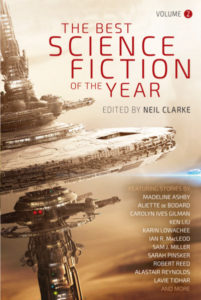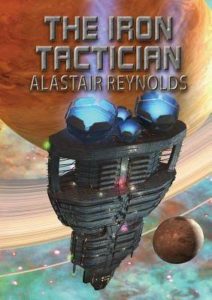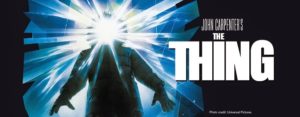Hankering for the best 2017 sci-fi shorts to add to your reading list? We’ve put together a review of some of our favorite short stories from The Best Science Fiction of the Year Volume 2, edited by Neil Clarke and published Night Shade Books. Have you read any of these yet? Let us know what you think!
“A Good Home” by Karin Lowachee A concise story in which the narrator, a wheelchair-bound war veteran, decides to take in a recently retired soldier android suffering from PTSD. The taciturn houseguest appears totally withdrawn, staring out the window for hours, mostly creeping out the neighbors. But the narrator, himself struggling to adjust to post-war life, manages to draw out his robotic roommate, who is capable of human feelings. The story’s climax occurs when the narrator’s emotionally abusive mother drops in to chastise her son, triggering the android’s “protective” mode and finding herself pitched out the first story window. In a brief denouement, human and machine bond over shared societal estrangement.
A concise story in which the narrator, a wheelchair-bound war veteran, decides to take in a recently retired soldier android suffering from PTSD. The taciturn houseguest appears totally withdrawn, staring out the window for hours, mostly creeping out the neighbors. But the narrator, himself struggling to adjust to post-war life, manages to draw out his robotic roommate, who is capable of human feelings. The story’s climax occurs when the narrator’s emotionally abusive mother drops in to chastise her son, triggering the android’s “protective” mode and finding herself pitched out the first story window. In a brief denouement, human and machine bond over shared societal estrangement.
“Prodigal” by Gord Sellar
A well conceived if slightly meandering story about a couple who believe they are infertile and thus decide to have their puppy, Benji, upgraded with a chemical treatment and “upper palate” surgery, making him both smarter and capable of speech. With light comedic touches reminiscent of Up, the seeds of disaster are sown early when Benji’s blossoming sentience causes him to question his treatment as a dog rather than a human being. When the couple discovers they can have a child of their own, the story grows darker. As the couple’s human child arrives and grows becoming a full member of the family, Benji’s treatment as an inferior becomes ever clearer to him. The ASPCA figures in somewhat heavily as more dogs are upgraded and made even more intelligent and articulate than Benji by dog rights’ activists championing the cause of canines. After violating the sacred rule of pooping indoors (an important symbol of the oppressive two caste society), Benji causes a scene at the family BBQ when he pees on a guest in a clear act of defiance before running away for good. In the last part, Benji joins an underground dog terrorist organization, which kills humans as a retribution for putting dogs down (murder). The appeal of “Prodigal” lies in the well crafted “what if” moments that any dog owner can relate to, and the story was reminiscent of “Flowers for Algernon” as Benji’s post-treatment mind rapidly evolves and, in turn, Planet of the Apes, especially the most recent movies in the franchise. But the story suffers from an uneven tone, light-hearted at times with many doggie adaptions like a smell-o-vision dog channel, scooters and equipment for sentient police dogs, mixed with a serious matter like terrorism, and an unsatisfying ending in which Benji is replaced with a non-sentient lab.
“Terminal” by Lavie Tidhar
A beautifully written, emotional story about people who are terminally ill or desperate to leave everything behind, traveling to Mars in cheap, one-person, one-way vehicles called “jalopies.” The occupants of jalopies communicate by radio only, each one confined in his or her compartment packed with necessary supplies and five hundred terabytes of music. The story has a lyrical, spiraling narrative as the passenger/settlers drift in and out of communication and recall deeply felt memories of earth. Most of the story focuses on the emotional toll of the journey, the loneliness of the passengers on the months-long trip and the dialogue among passengers of the swarm as they pass time however they can, from playing chess to falling in love, highlighting the necessity of human connections. The characters are mostly from the Philippines where jalopies are advertised on every street corner. The journey from Earth to Mars becomes a metaphor for the passage from life to death. The existence of Terminal Beach, their ultimate landing spot on the red planet, is somewhat ambiguous, an afterlife perhaps?
“The Iron Tactician” by Alastair Reynolds
This novella appears as the fourth entry in the author’s Merlin series of novellas, which began with “Merlin’s Gun” and continued in “Hideaway,” “Minia’s Flowers” and “The Iron Tactician.” However, new readers to the series shouldn’t be put off — no prior knowledge of the series is needed to enjoy the latest tale of the swashbuckling Merlin in this well-paced space opera filled with the kind of hard science fiction that makes Reynolds one of the  greatest writers working in the sub-genre today. While drifinting in his own damaged ship, Tyrant, Merlin encounters a hulking derelict “swallowship” which he believes might contain the gadget he needs to continue his quest to find a weapon to defeat the Huskers, an existential threat to all humanity. Instead, he discovers a lone survivor with a past more intertwined with his own quest than Merlin could have imagined. Reynolds’ gift for hard SF details are on full display as Merlin and his guest travel to another system via the “Waynet” — an ancient mechanism enabling interstellar travel and one of several technological wonders human spacefarers exploit with little understanding of how they function. As Merlin describes it, “we’re like rats, hunting for crumbs in the ruins they left us.” The two quickly become entangled in a millennial war between two inter-planetary clans trapped in devastating brinkmanship. The story’s title comes from an AI breakthrough developed by one faction which could give an edge ending the violence for good. Much of the plot revolves around Merlin’s attempt to recover the Tactician in exchange for a new “Syrinx,” a waymaker gadget that will allow him to repair his ship and continue his journey. Reynolds plans to continue with Merlin’s adventures, and “The Iron Tactician” sets up future tales quite well.
greatest writers working in the sub-genre today. While drifinting in his own damaged ship, Tyrant, Merlin encounters a hulking derelict “swallowship” which he believes might contain the gadget he needs to continue his quest to find a weapon to defeat the Huskers, an existential threat to all humanity. Instead, he discovers a lone survivor with a past more intertwined with his own quest than Merlin could have imagined. Reynolds’ gift for hard SF details are on full display as Merlin and his guest travel to another system via the “Waynet” — an ancient mechanism enabling interstellar travel and one of several technological wonders human spacefarers exploit with little understanding of how they function. As Merlin describes it, “we’re like rats, hunting for crumbs in the ruins they left us.” The two quickly become entangled in a millennial war between two inter-planetary clans trapped in devastating brinkmanship. The story’s title comes from an AI breakthrough developed by one faction which could give an edge ending the violence for good. Much of the plot revolves around Merlin’s attempt to recover the Tactician in exchange for a new “Syrinx,” a waymaker gadget that will allow him to repair his ship and continue his journey. Reynolds plans to continue with Merlin’s adventures, and “The Iron Tactician” sets up future tales quite well.
“They Have All One Breath” by Karl Bunker
A compelling “what-if” style short about a possible near future in which increasingly capable AI evolves nanobots capable of manipulating just about everything. The author makes reference to “The Machine Stops” by E.M. Forster, another story in which robots take control attempting to benefit mankind (“With Folded Hands” by Jack Williamson covers similar ground). What sets Bunker’s story apart is the fact that the AI never explains its rational or intent, which feels real and unsettling. One day, all military vehicles and weapons cease to function. Humanity gradually realizes that organized war is no longer possible. Just as suddenly, an abundance of food appears by drone-drop in refugee camps, ending starvation. Gradually all diseases and illnesses are cured as doctors discover “nano-sized foreign bodies of unknown origin in the blood of some patients. But soon it was in everyone’s blood, and everyone, everywhere, stopped getting sick. At all, ever.” Of course, this sparks fear among many who worry the AI (or AIs, no one knows which) might decide to wipe out humanity, but generally the world adjusts to the new order of “life of no war, no disease, and unearned abundance.” The story really gets traction when the central characters get married with hope of having a child, but find, like many others, the AI will not allow it. The AI seems to have decided that humanity has over-populated the world and selects only certain ideally suited couples to bestow the gift of procreation, but no one knows exactly what the AI uses for its criteria. Some married couples are allowed, as well as gifted teenagers, but despite their deep desire, the central characters cannot conceive. This revelation destroys their marriage. Years later, now alone and devoted full time to sculpting (because all jobs are essentially pointless when everything is abundant and free), the protagonist realizes that despite the absence of any kind of strife in the world, without the power to destroy, create and, most importantly make the mistakes required to learn and progress, humanity has been robbed of everything that made people special.
“Ten Poems for the Mossums, One for the Man” by Suzanne Palmer
A simple story, peppered with short poems, featuring a reclusive writer on an alien world who grows affection for creatures that are “half stone and half life” and manages to protect both Mossum and man from a larger T-Rex like predator. The setting is nicely described and uses the threat of a “swarming creature” called nochers attracted to electromagnetism as a conceit for eliminating any technology (communication, weapons, etc.) which would raises the stakes for the protagonist. The story also creates appealing anachronisms: “He is embarrassed by how much time he spent trying to figure out how to reboot the typewriter before he gave up and gently pressed the keys back into their proper places with his fingers.”
“Things with Beards” by Sam J. Miller In what amounts to a fan fiction sequel to John Carpenter’s The Thing, Miller uses the viral alien monster of the film as a metaphor for 1980’s homophobic reaction to the AIDS epidemic. It’s somewhat on the nose and tonally uneven, but the idea that the source of the alien’s destructive tendencies are caused by the fact that it can only reveal itself in absolute privacy is an interesting parallel. It’s well written and both an amusing and provocative comment on the film: “They all had their reasons for choosing McMurdo. For choosing a life where there were no women. Supper time MacReady would look from face to bearded face and wonder how many were like him, under the all-man exterior they projected, but too afraid, like him, to let their true self show.”
In what amounts to a fan fiction sequel to John Carpenter’s The Thing, Miller uses the viral alien monster of the film as a metaphor for 1980’s homophobic reaction to the AIDS epidemic. It’s somewhat on the nose and tonally uneven, but the idea that the source of the alien’s destructive tendencies are caused by the fact that it can only reveal itself in absolute privacy is an interesting parallel. It’s well written and both an amusing and provocative comment on the film: “They all had their reasons for choosing McMurdo. For choosing a life where there were no women. Supper time MacReady would look from face to bearded face and wonder how many were like him, under the all-man exterior they projected, but too afraid, like him, to let their true self show.”
“Touring with the Alien” by Carolyn Ives Gilman
Gilman explores an intriguing theme on the nature of consciousness in what is essentially an alien-road trip taken by a sympathetic protagonist and her symbiotic companions. Gilman wisely breezes through opening scenes describing several dome-shaped spaceships appearing in the sky similar to last year’s Arrival and, months after the media frenzy dies down, a “translator” emerging from each ship. Translators look exactly like us and, in fact, are human, having been abducted as children and raised by aliens for the purpose of interpreting our species via embedded neurotransmitters that allow the aliens (who appear briefly in the story and look like yellow sea sponge) to experience “feral” human life. Despite possessing far greater intelligence, the aliens are not conscious in the way that humanity understands. However, as Lionel (the translator who befriends the protagonist, Avery, tasked with driving him around the country incognito) describes it, Mr. Burbage (the individual alien who experiences human life through Lionel) and the other aliens have become addicted to human consciousness, which is thrilling for them but also burns them out, shortening their otherwise centuries-long lifespan. A little less sophisticated on the subject of intelligence without consciousness than Peter Watts’ brilliant novel Blindsight or even the HBO series Westworld, Gilman’s story is appealing. The alien road trip through through rural America was reminiscent of Starman (another Carpenter classic!). The story ends with an honest and ultimately unanswerable question: With all of the pain and misery that comes with being a conscious being, is it worth it or would we be better off without it?